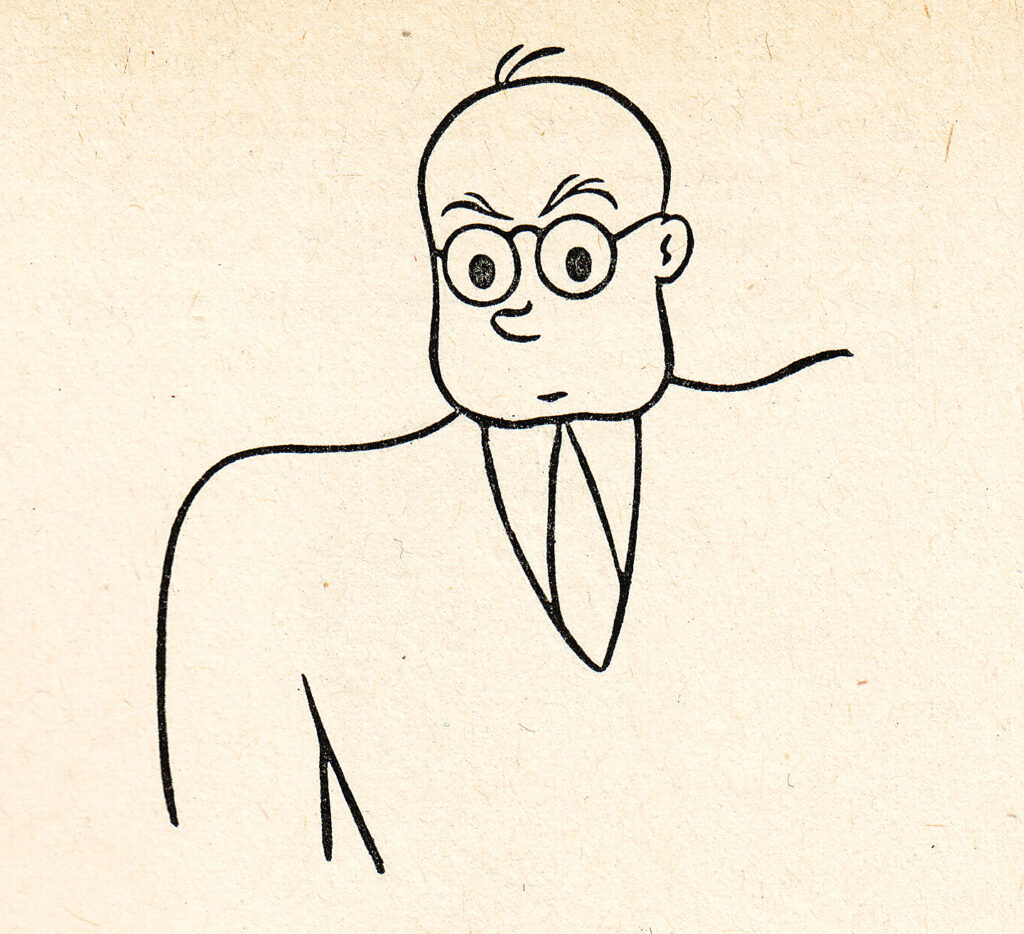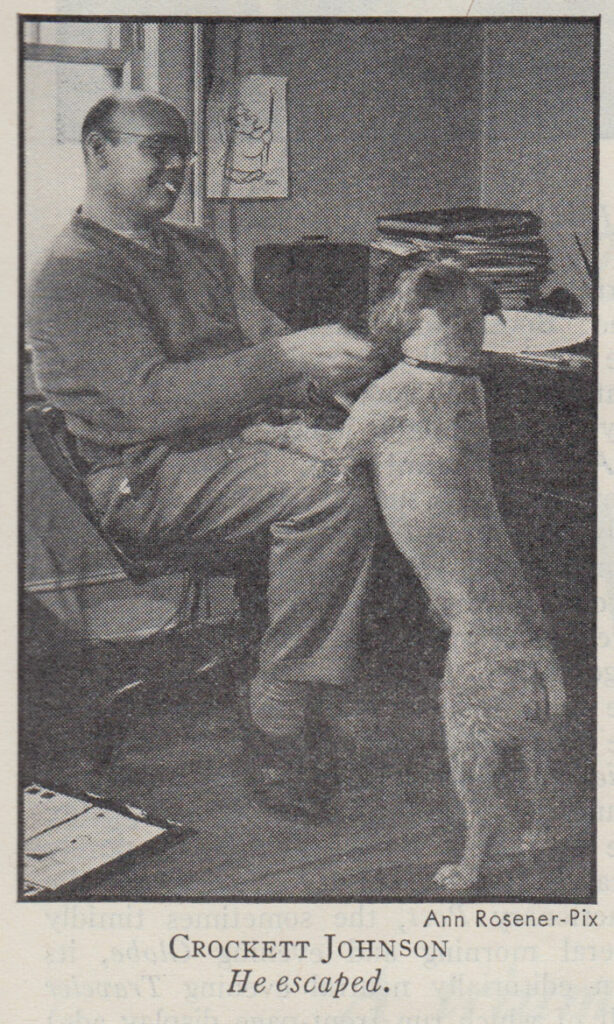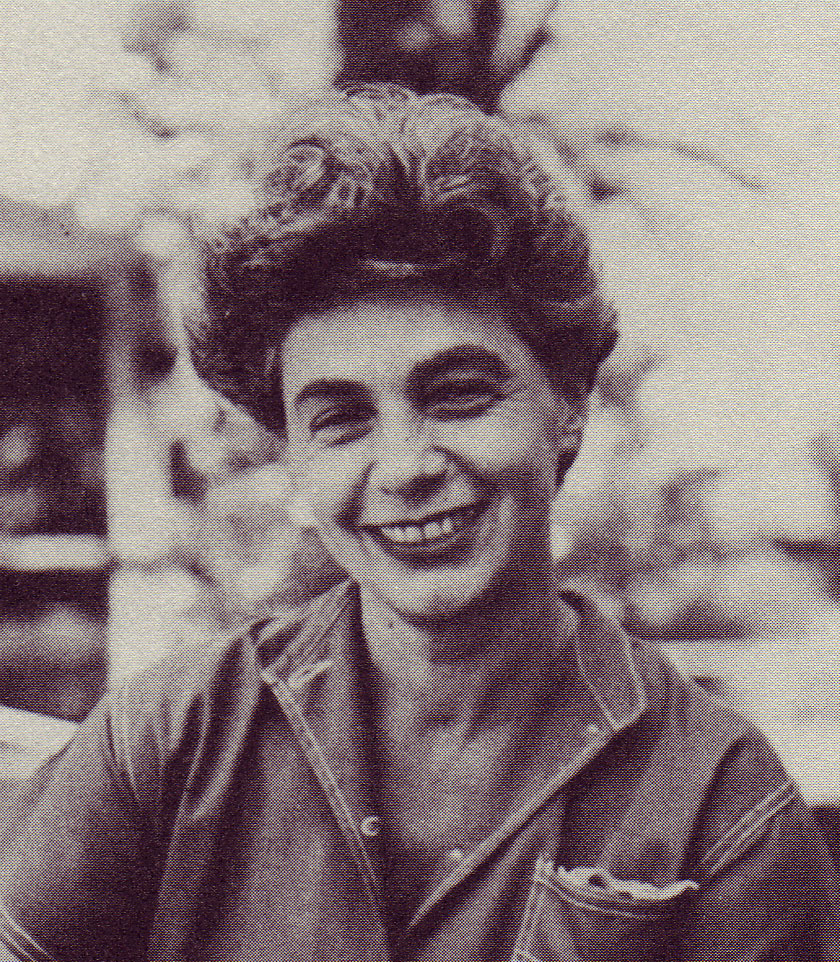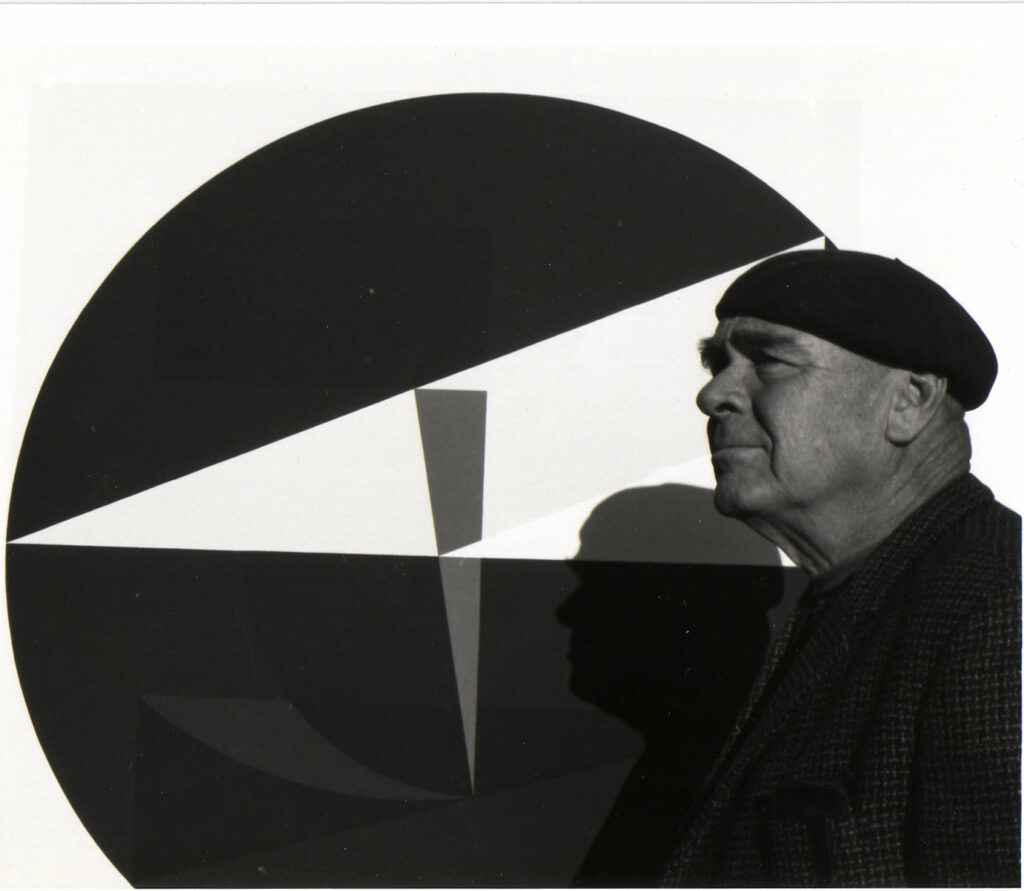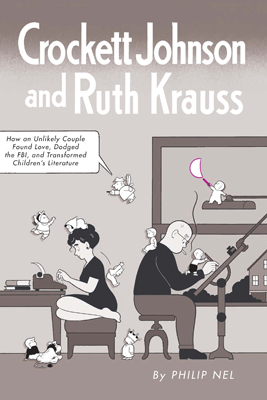Harold, Barnaby, and Dave:
A Biography of Crockett Johnson
by Philip Nel
On October 20, 1906, in New York City, David Johnson Leisk was born to David and Mary Leisk. Although born on East 58th Street, the young David grew up in Elmhurst, Long Island, where he went to high school and enjoyed sailing his boat in Long Island Sound. He studied art at Cooper Union in 1924, and at New York University in 1925. After his studies, he worked “in an ice plant, and in Macy’s advertising department, played professional football, art-edited several magazines and contributed to others,” as he told the authors of Illustrators of Children’s Books, 1946-1956 (1958).
Leisk wrote under the name “Crockett Johnson” because, he said, “Crockett is my childhood nickname. My real name is David Johnson Leisk. Leisk was too hard to pronounce — so — I am now Crockett Johnson!” (Hopkins 124). According to the Third Book of Junior Authors (1972), he was “six feet tall, tan, husky, and blue-eyed” (153). Like Barnaby and Harold (his two most famous characters), Johnson was bald. Referring to his hairless head, he once remarked, “I draw people without hair because it’s so much easier! Besides, to me, people with hair look funny” (Hopkins 121).
For a man who described himself as “the laziest man in the world” and claimed that he never intended to be an aritst (H.B.), Johnson had a remarkably productive artistic career. Between April 1934 and May 1940, he wrote political cartoons for the New Masses; from March 1940 through January 1943, he drew “The Little Man with the Eyes,” a weekly strip for Collier’s. In 1939, he met Ruth Krauss, who would soon become an author of children’s books, three of which — The Carrot Seed (1945), How to Make an Earthquake (1954), and The Happy Egg (1967) — he would illustrate. But before Johnson became a well-known writer and illustrator of children’s books, he created some of the most beloved comic-strip characters of the twentieth century.
“Barnaby” first appeared in the left-leaning newspaper PM on April 20, 1942, and was later syndicated in 52 American newspapers (with a combined circulation of nearly 5,600,000). The comic chronicled the adventures of a little boy named Barnaby Baxter and Mr. O’Malley, his bumbling Fairy Godfather. Barnaby’s parents never saw the Fairy Godfather, but readers knew he existed. As Duke Ellington claimed in a letter to PM, “tell Barnaby that I believe in Mr. O’Malley — solidly.” Ellington, who wrote in response to Mr. O’Malley’s praise for Ellington’s music (“That makes the admiration mutual,” Ellington said), was but one of the strip’s many famous admirers. Though known for her caustic wit, Dorothy Parker was sincere in her praise for Johnson’s comic: she wrote, “I think, and I’m trying to talk calmly, that Barnaby and his friends and oppressors are the most important additions to American Arts and Letters in Lord knows how many years.”
Johnson wrote “Barnaby” daily until 1946, when he handed over the task to Jack Morely and Ted Ferro. Both were neighbors of his in Connecticut: Ferro and his wife had written the radio serial Lorenzo Jones for 9 years; Morley once wrote editorial cartoons for the Journal-American. For eighteen months, Ferro co-wrote “Barnaby” (with Johnson as story consultant), after which Johnson resumed writing the strip and Morley continued creating the art. Johnson wrote and drew the final episode, concluding on February 2, 1952. During its run, “Barnaby” resulted in two collections: Barnaby (1943) and Barnaby and Mr. O’Malley (1944). Jerome Chodorov adapted “Barnaby” for the stage in 1946, Robert and Lillian Masters adapted “Barnaby” for children’s theater in 1948 (script published by Samuel French in 1950), and a “Barnaby” radio show aired in 1949. A Sunday-page “Barnaby” ran for a short time in the late 1940s, a live-action TV special aired on CBS in December of 1959, and “Barnaby” was revived briefly during 1960-1962 (updated by Johnson and redrawn by Warren Sattler), but failed after a few episodes. And, thanks to Judy-Lynn Del Rey (who oversaw their republication), Ballantine Books published six volumes of the original PM comic strips in 1985 and 1986. Fantagraphics Books began reprinting the entire ten-year run of the strip in 2013.
If “writer of comic strips” characterizes the first phase of Johnson’s career, the second phase is clearly “author and illustrator of children’s books.” Starting with Who’s Upside Down? (1952), Johnson wrote and illustrated over 20 books for children, providing illustrations (but not the story) for 7 more (beginning with Constance Foster’s This Rich World in 1943 and Krauss’s The Carrot Seed in 1945). He described his style of illustration as “simplified, almost diagrammatic, for clear storytelling, avoiding all arbitrary decoration” (Lee, et al. 126). Like Harold, the small boy whose purple crayon leads him through many expeditions, Johnson’s style is clear, minimalist, and very effective. Harold, the protagonist of his best known series, began his many journeys in Harold and the Purple Crayon (1955), which was followed by Harold’s Fairy Tale (1956), Harold’s Trip to the Sky (1957), Harold at the North Pole (1958), Harold’s Circus (1959), A Picture for Harold’s Room (1960), and Harold’s ABC (1963). In appearance, Harold could be a cousin of Barnaby; but, instead of a Fairy Godfather, Harold’s accomplice is his purple crayon. Harold draws his universe and walks through it, using his purple crayon to create and escape from his adventures, always ending up safe (usually at home) by the book’s final page.
At about the time of his marriage to Ruth Krauss in the early 1940s, the couple moved first to Darien, Connecticut, and by 1946 to Rowayton, a small town on the northern shore of Long Island Sound, where he often sailed. During the time the Johnsons lived in Rowayton, Maurice Sendak, who illustrated eight of Krauss’s books, spent many weekends at their home, learning about — and collaborating on — children’s books. Describing his “apprenticeship,” Sendak recalls weekends spent at their “big rickety frame house by a river with a boat” when he was but 23 years old, and his account provides a glimpse into life and work at the Johnson-Krauss household in the early 1950s:
Ruth and Dave [alias Crockett] became my weekend parents and took on the job of shaping me into an artist. I was a good apprentice and A Hole Is to Dig, in 1952, was my official baptism into picture books. I remember the porch table covered with a million (it seems) bits of Krauss words and thinkings, encircled by my little scratchy, dumpy doodles. Ruth and I would arrange and rearrange and paste and unpaste and Ruth would sing and Ruth would holler and I’d quail and sulk and Dave would referee. His name should be on all our books, for the technical savvy and cool consideration he brought to them. There was an impressive silence about Dave (he was the most giant of all!), and after Ruth had gone to bed I’d hang around with him, hoping he’d open up and waiting for my weekly reading list. (Sendak 287-88)
Sendak considers himself a “lucky kid” to have been able to work with Krauss and to spend time with Johnson.
During a summer afternoon in the late 1960s, Lee Bennet Hopkins visited their house in Rowayton, and his interview offers a happy portrait of the couple’s life on the Connecticut coast. They were full of good humor and amusing anecdotes (“Even today I can hear the strains of Ruth Krauss’s ‘hee, hee, hees’ and Crockett Johnson’s ‘ho, ho, hos’ whenever I pick up A Hole Is to Dig or Barnaby,” Hopkins concludes). Though generally content in their suburban home, Johnson did say, “It was a nice neighborhood here until the young fogies moved in and spoiled it. The lake is so crowded now that there isn’t even enough room to go sailing” (121). Never a “fogey,” Johnson remained versatile and inquisitive, receiving in 1955 a patent for a four-way adjustable mattress. In that same year, he published “Fantastic Companions,” a gently satiric essay on children’s imaginary friends: his tales of Barnaby’s Fairy Godfather inspired parents to send stories of their children’s fantastic companions, and Johnson recounts some (with illustrations) in the article. Johnson and Krauss lived in Rowayton until they moved to Westport in about 1973 and, in addition to sailing and inventing, writing and illustrating children’s books remained Johnson’s primary occupation until about 1965.
At that point, what formerly had been a hobby became his full-time pursuit. Johnson explained, “upon belatedly discovering aesthetic values in the Pythagorean right triangle and Euclidian geometry, I began a series of geometric paintings deriving from famous mathematical theorems, both ancient and modern” (“On the Mathematics of Geometry…” 97). During what might be called his third career, Johnson painted about 100 large, vivid canvases of geometric shapes, often using a computer to plan the shapes for his abstract, mathematical ideas. He characterized these works as “non-objective, mathematic and geometric,” and was not only “proud of a notice in the British Mathematical Journal in 1974 of his rendering of a seven-sided figure for an article” (Marschall 449) but also contributed original geometrical theorems to the Mathematical Gazette in 1970 and 1975. His paintings were exhibited at the Glezer Gallery (New York City) in 1967; the Museum of Art, Science and Industry (Bridgeport, Connecticut) in 1970; the IBM Gallery (Yorktown Heights, New York) in 1975; and the Smithsonian’s Museum of History and Technology (Washington, DC) in 1980. The man whose eclectic career included creating Barnaby, Mr. O’Malley, and Harold, inventing an adjustable mattress, and painting professionally, remained curious and active to the end of his life.
Johnson died of lung cancer on July 11, 1975; he was 68. Ruth Krauss outlived her husband by nearly two decades, and continued writing stories for children and poem-plays for adults. She died on July 10, 1993, exactly one day before the 18th anniversary of Johnson’s death, and two weeks shy of her 92nd birthday.
To see the sources for the above, please see the Bibliography.
Like to learn more?
- Read my biography, Crockett Johnson and Ruth Krauss: How an Unlikely Couple Found Love, Dodged the FBI, and Transformed Children’s Literature (University Press of Mississippi, 2012). 88 illustrations.
- Read my much shorter biographical essay on Crockett Johnson (pdf), which appeared in the (sadly defunct) Comic Art in February 2004.
- Visit Nine Kinds of Pie (my blog) for yet more about Crockett Johnson, Ruth Krauss, and other projects.
- To learn still more, Nine Kinds of Pie featured many glimpses of the work in progress, as well as items cut from the final manuscript. For example:
- Appendix A: American Committee for Spanish Freedom (July 2011). I cut all four appendices. This is the first one.
- Appendix B: We Are for Wallace (July 2011). And this is the second one.
- Appendix C: Assembly of Men and Women in the Arts Concerned with Vietnam (Sept. 2011). The third one.
- Appendix D: End Your Silence (Sept 2011). The fourth one.
- Crockett Johnson’s FBI File, Part 1 (24 Apr. 2012). The first 15 pages of Johnson’s file.

